Italian Line S.S. Leonardo da Vinci 1960 - 1982
Please Note: Firefox and some
other search engines are not suitable
Use Google Chrome for this page to load perfectly!

Click the logo
above to reach the ssMaritime FrontPage for News, Updates & “Ship of
the Month”
Please Note: All ssMaritime and other related maritime sites are 100% non-commercial
and privately owned, thus ssmaritime is NOT associated with any shipping
company or any other organisation! Although the author has worked and been
involved in the passenger shipping industry for well over 60 years, but due to
his old age and poor health, he was forced to retire. Yet, he has completed
well over 1,365 Classic Liners, Passenger-Cargo Liners as well as humble
converted C3 converted Migrant Liners, which has transported countless
thousands folk to the new world, as well on vacations’. I trust the
features online will continue to provide Classic Liner and Ship enthusiasts
both the information they are seeking, but more so provide a great deal of
pleasure and relive many happy memories!
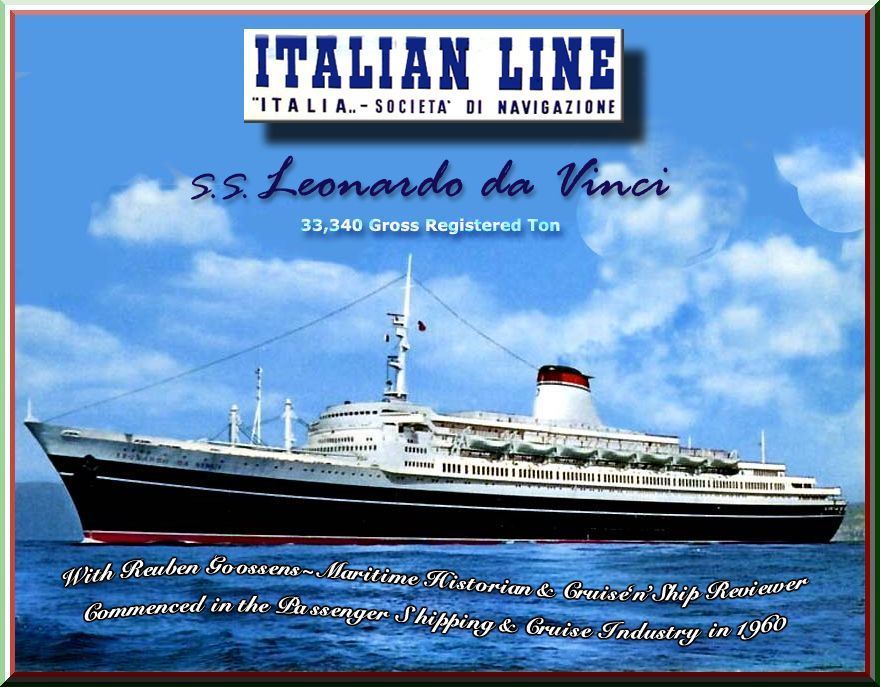
Please Note: Photographs are from the ssmaritime collection, or as mentioned
otherwise
Page One
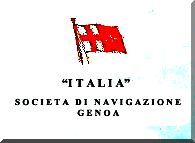
“Leonardo
da
Vinci’s”
History & Specification Page
Including
some of “Italia Lines” earlier Liners in brief
With Reuben
Goossens
Maritime
Historian, Cruise‘n’Ship Reviewer, Author and Lecturer
Commenced
in the Passenger Shipping & Cruise Industry in 1960
Introduction:
The Italian Line like so many of
its competitor’s lost most of its passenger liners during World War
II, including two of their prestigious luxury liners the
superb S.S. Rex as well as the magnificent S.S. Conte di Savoia.
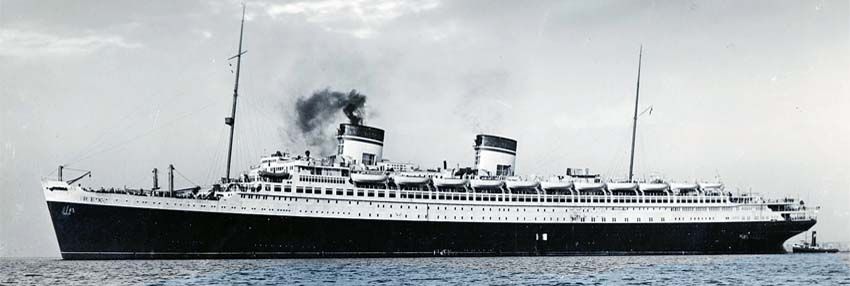
Above
the luxurious S.S. Rex and below the S.S. Conte di Savoia,
both commenced service in 1932
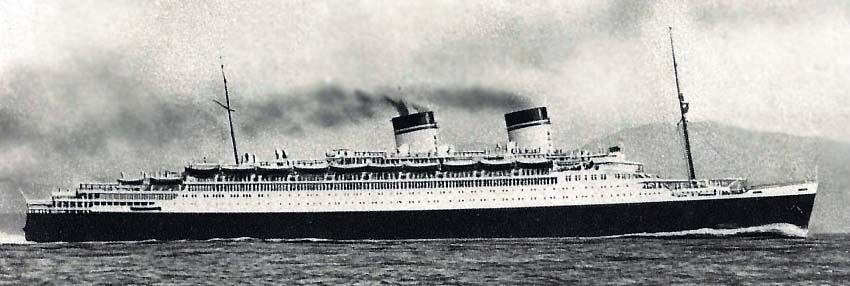
The
luxurious S.S. Conte di Savoia
But the liners that did somehow manage to
survive the war, mostly dated from the 1920’s and these ships by the late
1940’s were due to be replaced.
Thankfully, in 1949 the
Italian Line received special subsidies from the Italian government for them to
construct two new liners for their Trans-Atlantic service between Italy
and the United
States.
The first of these ships was delivered in 1953 being the S.S. Andrea
Doria,
and she was followed the very next year by the S.S. Cristoforo
Colombo.
Together these two liners re-established the Italian Line’s prestige
Trans-Atlantic service with two of the finest liners to serve on the respective
service.
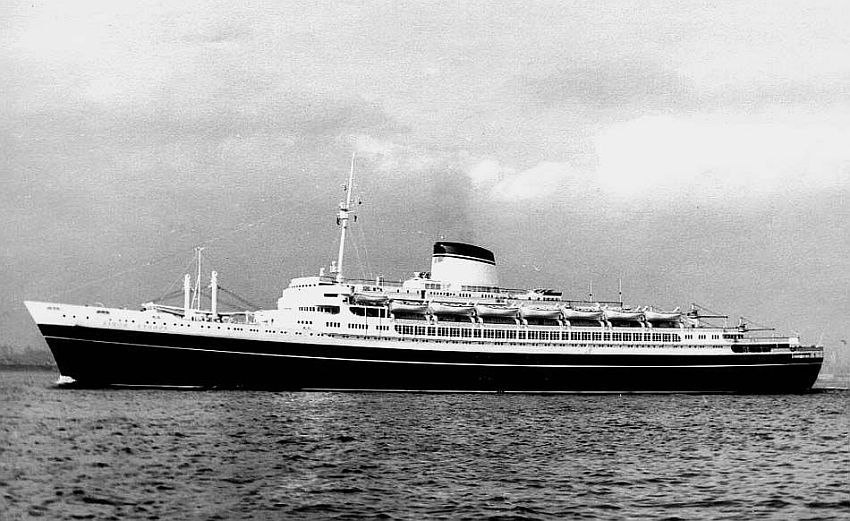
Here
we see the elegant S.S.
Andrea
Doria
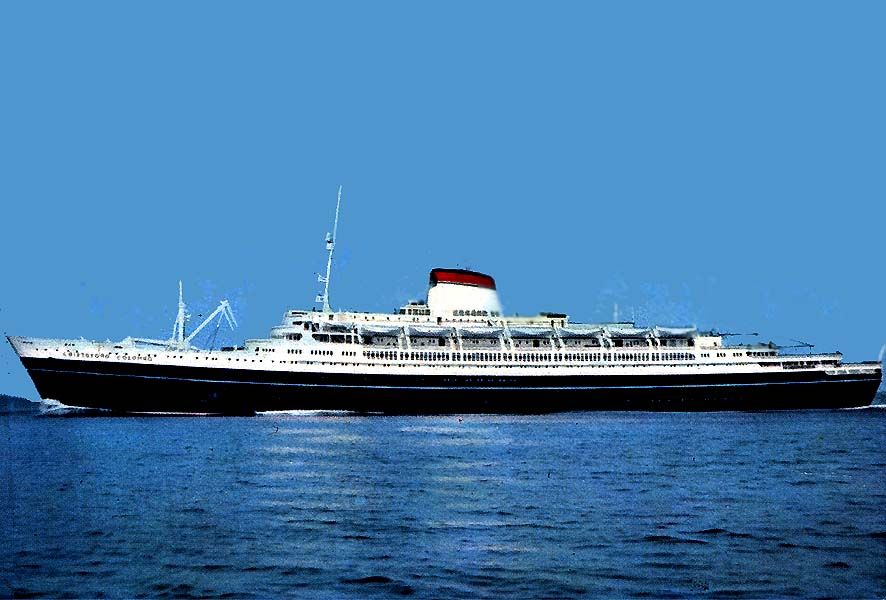
This
is the slightly newer sister the S.S. Cristoforo
Colombo
However, as history proved, the Andrea
Doria
collided with the Swedish American Line M.S. Stockholm and the great
Italian liner sank due to the collision, whilst the much smaller Stockholm
suffered damage to her bow. The Stockholm
did assist and she was able to rescue many passengers from the Andrea
Doria.
The much loved and admired Andrea
Doria sank
after just three years of service on July 25, 1956 which was a great loss to
the company, besides the Italian Line was left to pay the full cost of their
lost ship, due to negligence on the bridge that night, whereas the Stockholm
only had to pay for their bow repairs. Sadly the vast majority of the blame was
laid on the Andrea
Doria,
which was tragic for the Italian Line had a long record of excellent maritime
safety!
A New
Ship in Planning:
But with
the tragic loss of the Andrea
Doria,
the Italian Line was now short of a ship and they desperately required a new
liner to join S.S. Cristoforo
Colombo on their Trans-Atlantic service.
However, amongst the board of directors of
the Italian Line there was considerable turmoil regarding the collision and the
ensuing court case, etc. But thankfully there was a part of the company that
commenced to work on plans for a new ship that was so urgently needed to
replace the lost ship.
Maritime architects decided to use the very
same hull design as that of the SS Andrea Doria, but
adapt it, and update it into a larger design for the new ship. The Andrea
Doria
was 29,083 GRT and 701 ft long and 90 ft wide, whilst the design of the new
liner would be 33,340 GRT and 763.12 ft long and 92.19 ft wide.
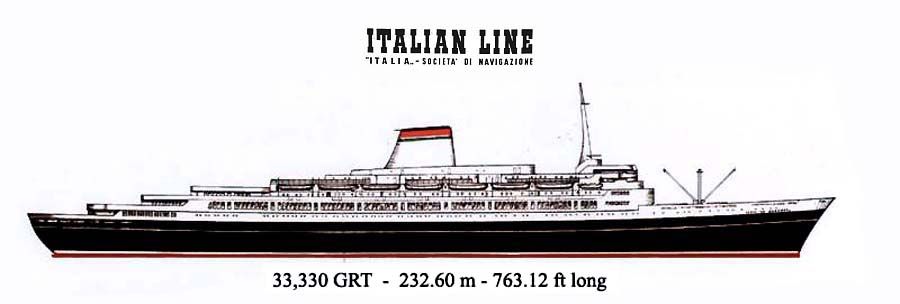
This
silhouette was a first look of what the ship would look like
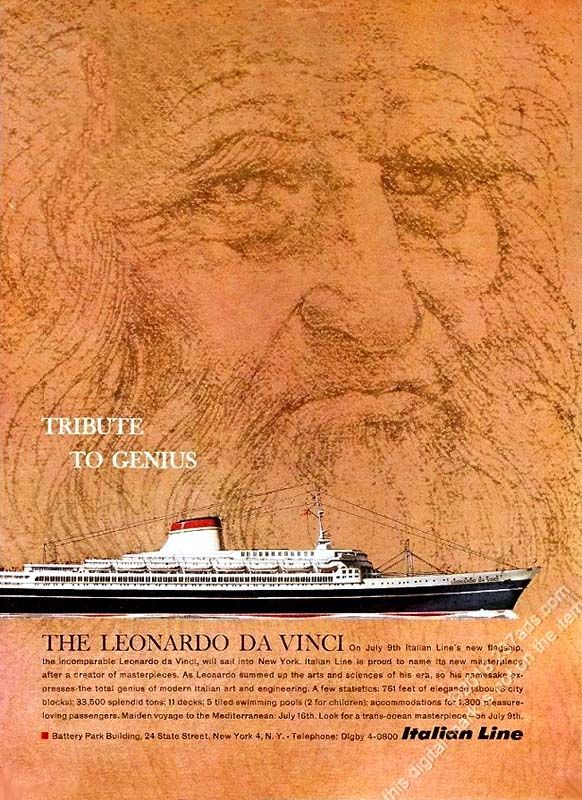
Italian
Line’s released this Leonardo
da
Vinci brochure in 1960 and
considering the ship was named
after one Italy’s
greatest innovators ever, it was obvious the new liner would represent the very
best in INNOVATION!
This
is the cover of the brochure but sadly I do not have its interior
Brochure
cover provided by Jason
Macinnes,
Scotland
As plans progressed many innovations were
made for the new liner, as she would incorporate very high standards and many
fully upgraded safety features, and as the plans for the new ship came towards
a conclusion, there was no doubt at all that she would be one of the most
advanced liners of her time!
New
safety features included:
The liner would have lifeboat davits that
would be capable of launching lifeboats against a 25 degree list, as well as
lifeboats would be fully motorised, also her watertight bulkheads would be
extended. Another astonishing innovation was, that her engine rooms would be
separated into two compartments one located forward and one just aft, with each
engine driving its own propeller and thus being capable of powering the ship
independently from the other. Another great innovation was, considering the Andrea
Doria
was not known for her stability, the new ship would be provided with not just
the usual two stabilizer fins, but four “Denny Brown” stabilizers
fins.
There were a good number of other notable
features and innovations such as; an Infrared-heated swimming pool in First
Class, all First Class and Cabin Class cabins, as well as 80% of Tourist-Class
cabins were provided with private facilities, and the ship would be fully
air-conditioned. Whilst the Andrea
Doria
and her newer sister had three electric cranes located on their aft decks,
servicing their holds there, the new ship would be completely free of any
cranes, thus providing spacious Lido Decks with fine Swimming Pools and Sun
Decks.
But I left one thing out, as they say the
“Big Daddy” of the story, for the Leonardo
would be given one of the most unusual features in passenger liner history. The
truth is that provisions were made to convert the ship in due course to operate
on Nuclear Power whenever it should become available. We know that the American
“State
Maine Lines” built the N.S. Savannah being the world’s first nuclear powered Passenger-Cargo
liner, and she commenced her maiden voyage on August 20, 1962. But, although
she did have passengers, but sadly she was seldom booked to capacity, due to
many people being fearful of being exposed to radiation, etc, and thus this
magnificent looking ship proved to be a complete failure. In due course she
operated as a cargo ship and finally she became a stationary museum, and in
this role she has been more successful than she ever was as an operational
passenger ship!
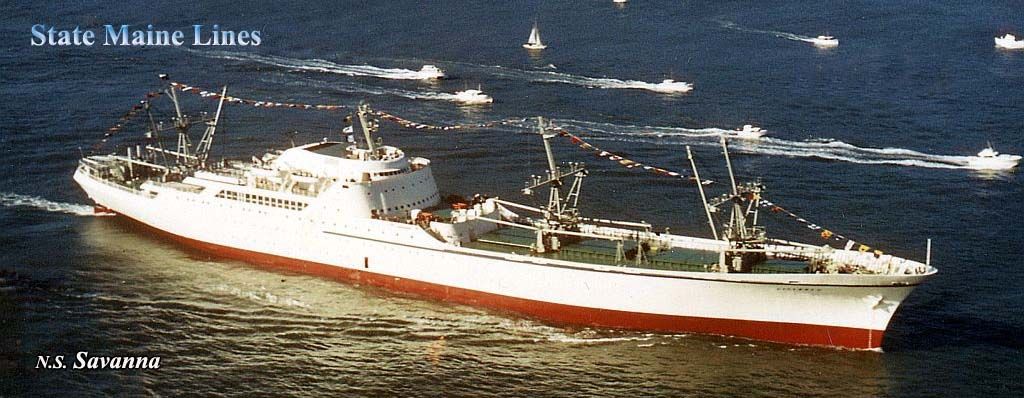
N.S.
Savanna seen arriving at Seattle in 1962 for
the World Fair
Construction
& Launching:
The famed shipbuilder “Ansaldo
Sestri
Ponete” of Genoa,
which commenced ship building in 1815, was given the contract in 1958 to build
the ship that would be named later at her launching “Leonardo
da
Vinci”. She was laid
down in Yard 1550, and as work commenced it did not take too long before her
hull stood tall.
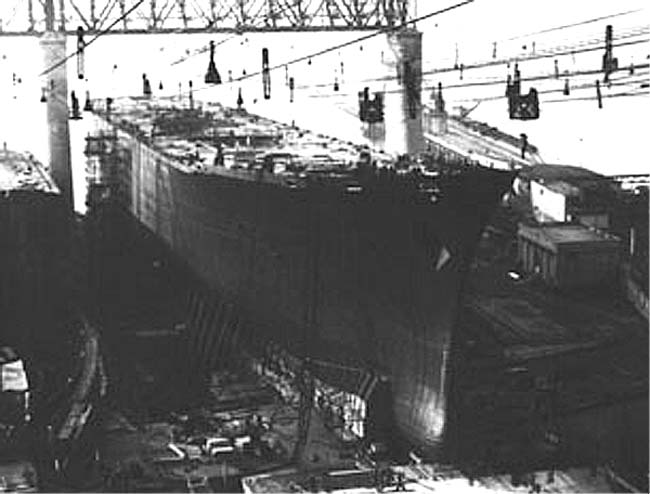
With
her hull completed, the great new liner is seen a little over a month prior to
her launching
Then came a big day for this
fine new ship, for on Sunday December 7, 1958 she was launched and officially
named “Leonardo da Vinci” by Mrs. Carla Gronchi,
the wife of Giovanni Gronchi, being
the President of the Italian
Republic.
and the Leonardo
da Vinci
gently slid down into the water and was taken into tow to Ansaldo’s
fit-out berth to be completed.
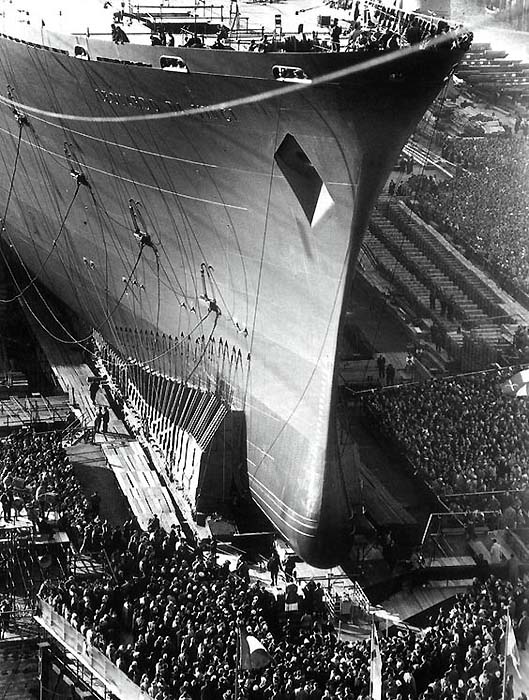
Leonardo
da
Vinci is seen during her
triumphant launching on December 7, 1958
The Italian Line commenced a promotional
opportunity and as they had built a perfect scale model of their new liner the Leonardo
da
Vinci, it received a
popular viewing Trieste
in April 1960.
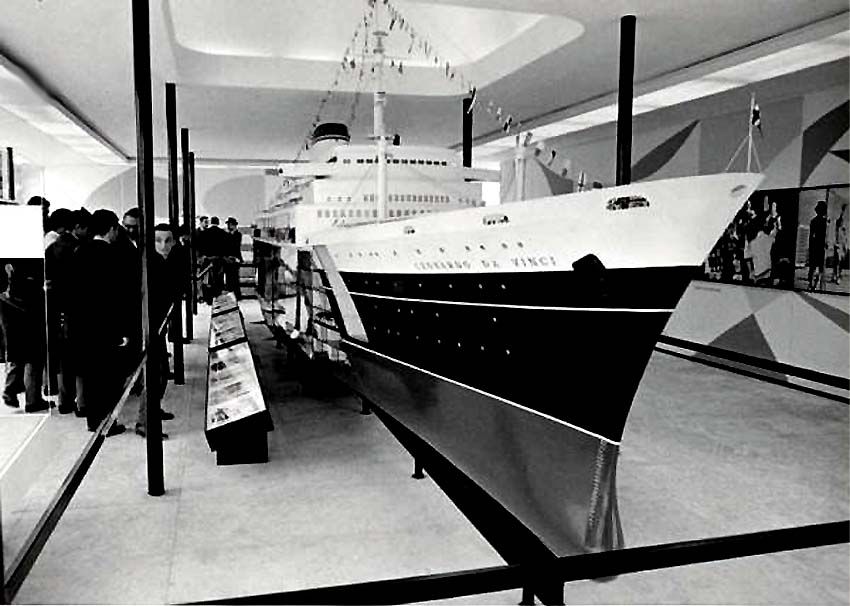
Here
we see a huge model of the Leonardo
da
Vinci at the Milan Fair in
April 1960 and the model reveals her beautifully shaped bulbous bow
On Thursday May 19, 1960, S.S.
Leonardo
da
Vinci undertook her Deep
Sea Speed Trials which she did with great success, at first she reached a top
speed of 25.3 knots and then on her next run she achieved a remarkable 26
knots. However whilst on her Trans-Atlantic services, she would usually operate
at a service speed of around 23 knots.
Looking simply sublime, like a perfectly
polished gem the S.S. Leonardo da Vinci was delivered early to her owners in Genoa
in June 1960 and there she was made ready for a short “shake-down
cruise” which departed Genoa on June 17, this gave the crew the opportunity
to get used to the new ships and the surroundings as she was quite different to
their previous liners. The cruise went well, and upon her return the media on
board gave her a stunning review! Now she was ready for her official maiden
voyage to New
York.
But let us first take a closer look at this amazing ship, her excellent
features and one that was not that great, which follows next.
As was discovered during her sea trials,
sadly just like the S.S. Andrea Doria and Cristoforo Colombo, the Leonardo da Vinci, even
with her four stabilizer fins, she still proved to be prone to instability in
rough weather, and this was due entirely to her hull design. The main problem
being is that her designers took Andrea
Doria
hull design and simply stretched and widened it, but somehow this really did
not work for a larger version and it affected her stability. Thus it was
decided to fit 3,000 metric tons of iron onto the bottom of her hull,
and it was stated that this was done to “improve her stability”.
However, this caused a huge problem, for it now made; “The Leonardo da
Vinci excessively heavy for the power of her engines” and sadly this led
to fuel costs for her being extremely expensive, especially during a time of a
fuel crisis, and fuel costs would obviously affect her eventual future!
Her
Interiors
Due to the possible conversion for the ship
to operate in the future on nuclear power, the Leonardo
da
Vinci had what would be known
as a rather different interior layout to the majority of passenger liners. The
reason being, that the location for the future reactor was located amidships,
thus in and around the liner’s steam turbine power plant. Therefore it
was necessary to locate the dining rooms and galleys one deck higher than they
had been on the Andrea
Doria
and Cristoforo Colombo,
thus it was separated from the ship's main working area. There are no passenger
hallways that pass the area that is reserved for a reactor, meaning that the
forward and aft passenger sections of the lower decks were complexly separated
from each other. Mind you, that would also be the case in a good number of
other ships in due course that had no thoughts of a reactor, there it was just
the fact that the engine room separated forward from aft, and it was no big
deal!
In addition she became the first Italian
liner to be fitted with an efficient water desalination plant with a capacity
of over 184,000 gallons of fresh water per day. She also had two garages for 50
cars; one the First Class garage had a fold down door and cars could just drive
on and off.
Some of the ships thirty Lounges, Dining
Rooms and other public spaces on board were designed by several famed Italian
designers, which included Vincenzo Monaco and Amedeo
Luccichenti and these two men were responsible for the sublime Ballroom and Cocktail
Bar, whilst other amazing designers worked on the rest of the venues.
Closed-circuit Televisions were located in all the Main Lounges. The Leonardo
da
Vinci had a total of 524
cabins, accommodating 1,326 passengers in her three classes, First, Cabin and
Tourist-Class, all being exceptionally fitted out according to their class.
The Italian Line published a brochure full of
artist impressions long before the completion of the ship, and this brochure
and a later one from 1966 are shown in full on Page Two. Her Deck Plan will be
shown on Page Three.
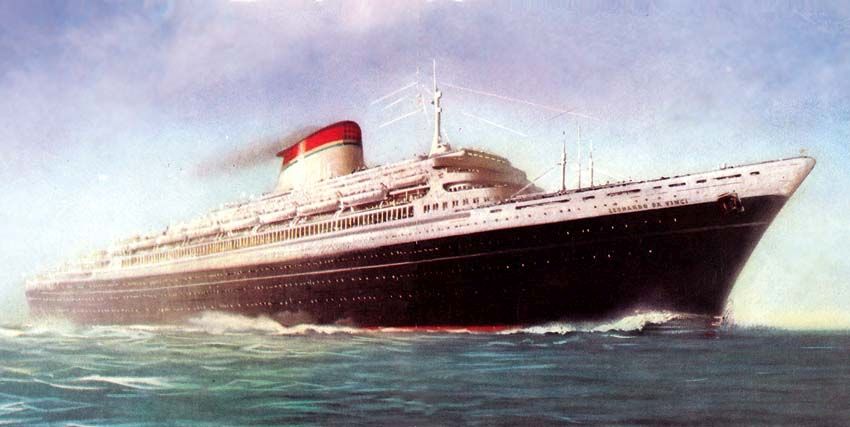
An
advanced artist impression of the S.S.
Leonardo
da
Vinci from the Italian
Line’s 1958 brochure
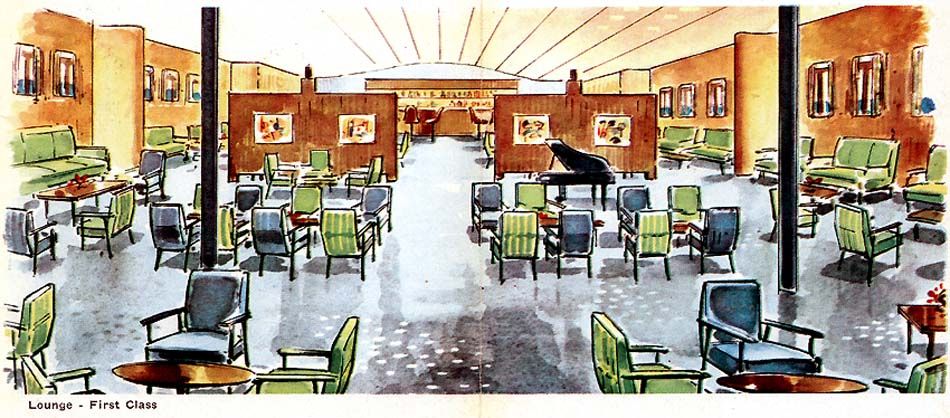
The
First Class Lounge from the abovementioned advance brochure
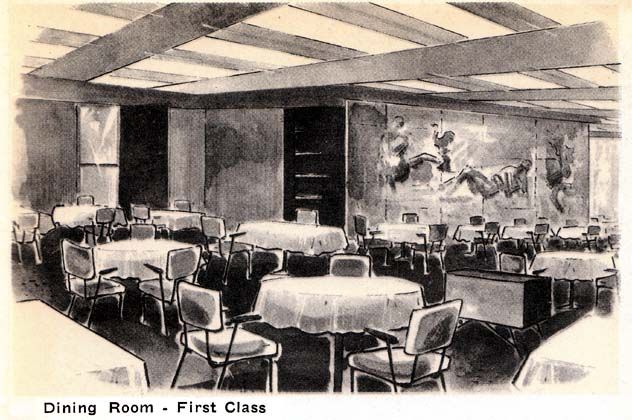
A
black & white impression of the First Class Dining Room, revealing the
sculptures along the wall as can be seen below
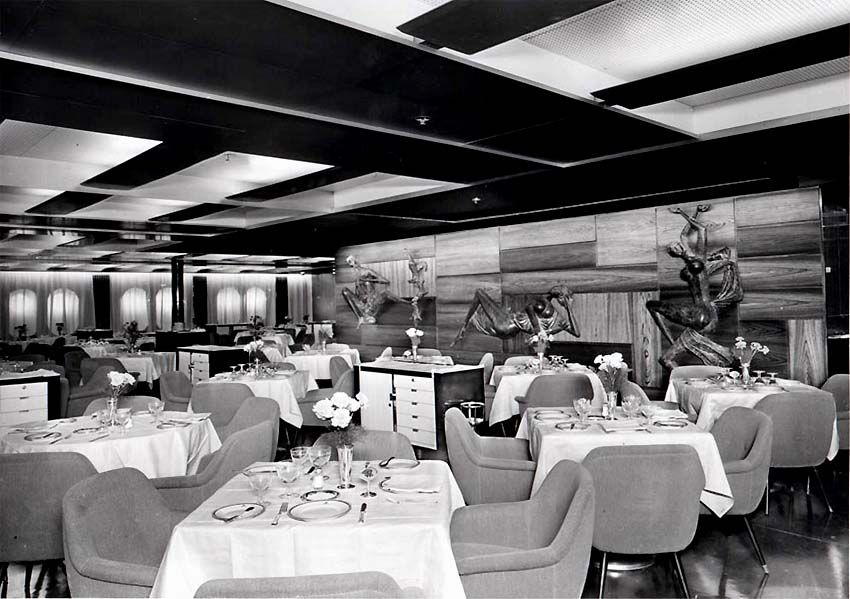
And
here is the actual elegant First Class Restaurant, featuring a wall of fine
timbers and four stunning sculptures
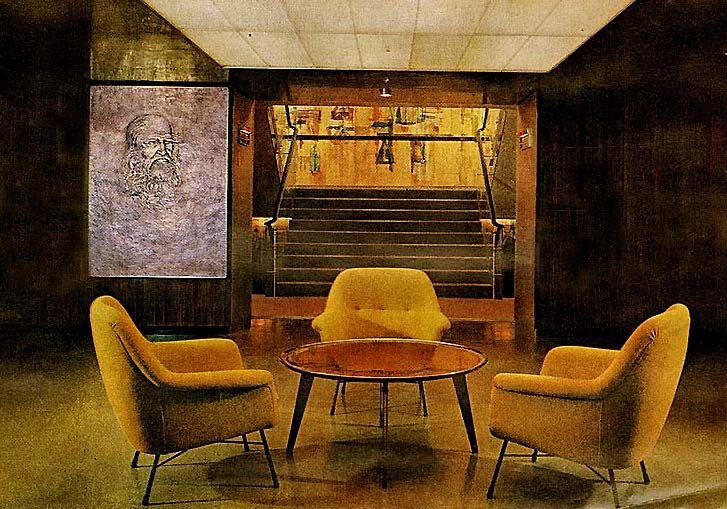
The
liner’s namesake is seen here in the First Class Lobby, where he is
honoured by a large hammered silver relief
portrait of Leonardo
da Vinci
by famed Italian artist & sculptor Renato Marino Mazzacurati (1907 - 1969)
Exterior:
The exterior design of the Leonardo
da
Vinci was somewhat similar to
that of her two earlier sisters, but she was 63 ft longer and a good 2 ft
wider, in addition she had a larger forward as well as an aft superstructure. The
ships funnel was also beautifully re-shaped into a more modern shapely funnel,
as well as being somewhat taller and also having a small smoke deflector fin.
The Leonardo
had the same livery as the Andrea
Doria
and the Cristoforo Colombo having a perfectly painted
black hull with a thin white band painted two-thirds of the way up from the
bottom of the black-painted area.
There is no doubt externally, and I do mean
visually, S.S.
Leonardo
da
Vinci was a perfectly
balanced looking liner, just simple perfection to behold at sea, be it back
then and honestly she would still be today!
But sadly, her machinery was under powered
and thus it was difficult to cope with the ships very poor underwater hull
design and all that iron that had to be fitted to keep her stable, thus fuel
cost added up to a fortune to operate her, and tragically that was the ships
main downfall and a big problem. Due to the aforementioned this wonderful ship
as far as passengers were concerned, her days were considerably short for such
a sizable liner serving the Italian Line for she only served a total of 17
years, and then she was laid up several times for a good number of years. Such
a magnificent looking ship, with interiors fit for an Emperor, she certainly
deserved much better!
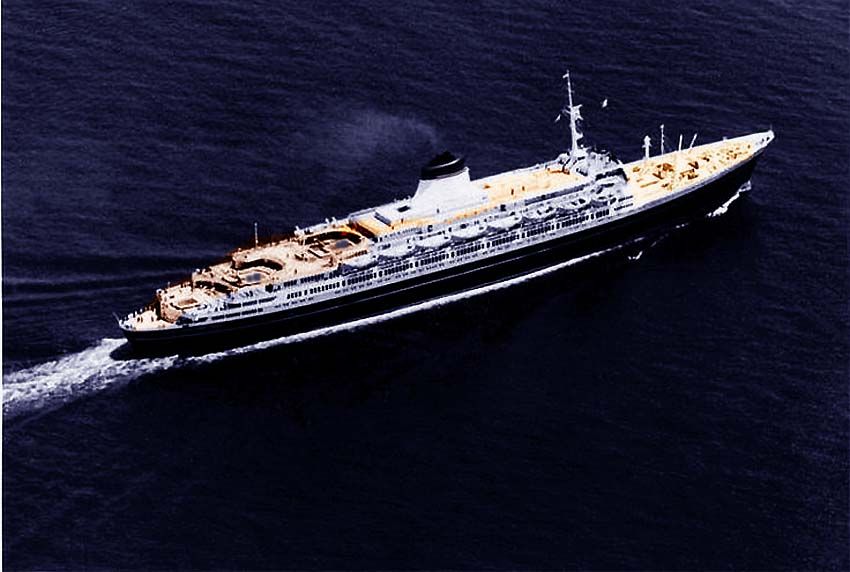
A
aerial view postcard of the sleek S.S.
Leonardo
da
Vinci at sea
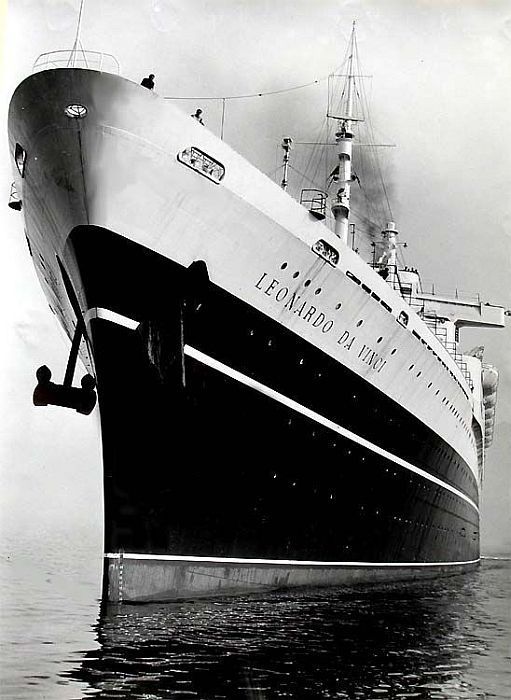
Here
is a fine photograph of her shapely bulbous Bow
Maiden
Voyage:
On June 30, 1960, under the command of the
company’s Senior Captain; Commander
Armando
Pinelli
S.S. Leonardo
da
Vinci departed
Genoa
on her maiden voyage. She first headed for Cannes
where she arrived later on that day. She the arrived at Naples
on July 1, and Gibraltar on July 3, after which she
headed directly for New York
where she arrived July 9. Upon arrival in the “Big Apple” S.S.
Leonardo
da
Vinci received a Grand
Welcome, which new liners were traditionally given as they arrived in the City
on their Maiden arrival.
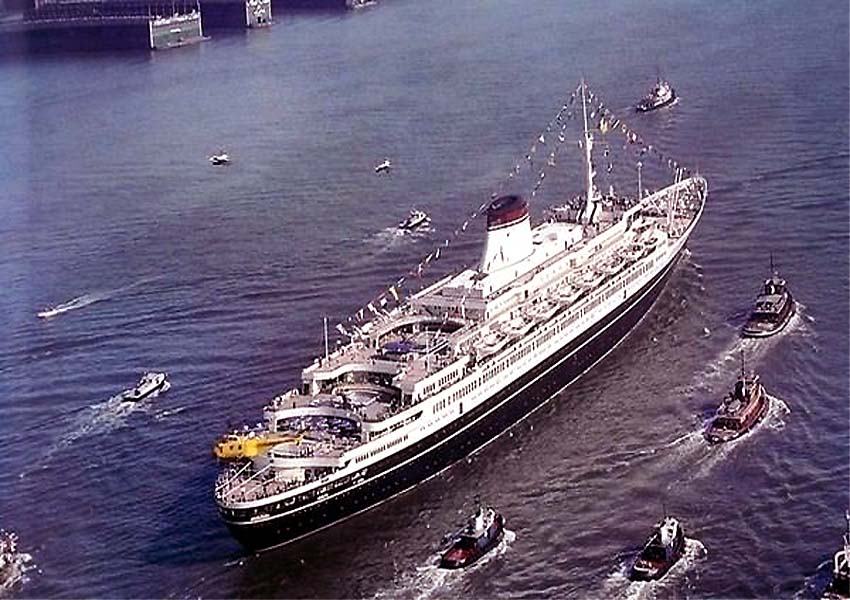
An Italian Line postcard of Leonardo
da
Vinci’s maiden
arrival in New
York City
Not long after the Leonardo
entered the Trans-Atlantic service, amazingly the Italian Line announced that
by 1965 that their new ship would be refitted to operate on nuclear
power. But as we know, that never came about, and to be honest it was just
as well, for all too soon big changes were going to happen.
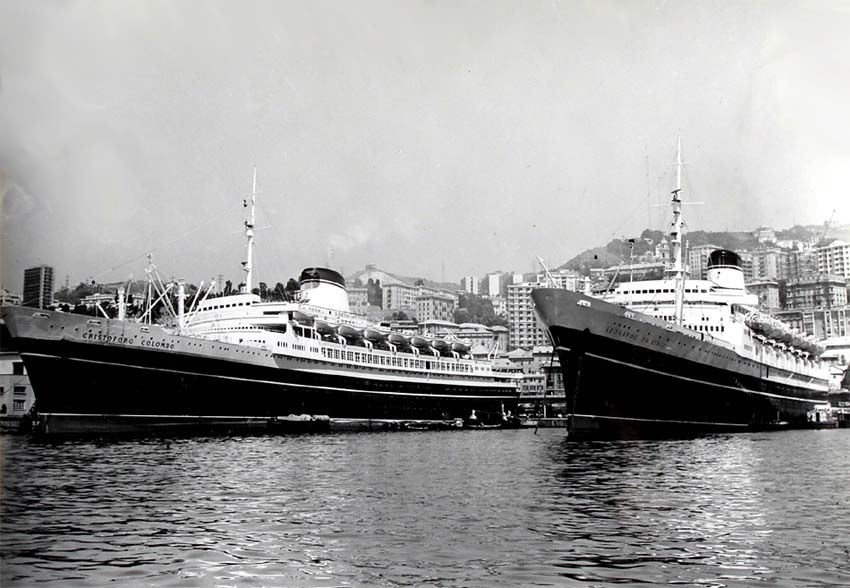
S.S.
Leonardo
da
Vinci (right) and Cristoforo Colombo are seen together at Genoa.
Amazingly the
Cristoforo Colombo seems to look
larger than the Leonardo
da
Vinci, but that is an
allusion.
It had already been decided by the Italian
Line that the Leonardo
da
Vinci would be replaced on the North
Atlantic
service by their two brand new liners the S.S. Michelangelo and S.S. Raffaello
mid 1965. Thus the Leonardo
da
Vinci continued on her regular
North Atlantic service from Genoa
to New
York
until July 1965.
When she completed her Trans-Atlantic
services in July 1965, she commenced to operate a new service and she departed
on her new Trans-Atlantic service, but now from Naples
to New
York,
with her first departure from Naples
being on July 19, 1965, however, by the end of the year she would return to
cruise duties.
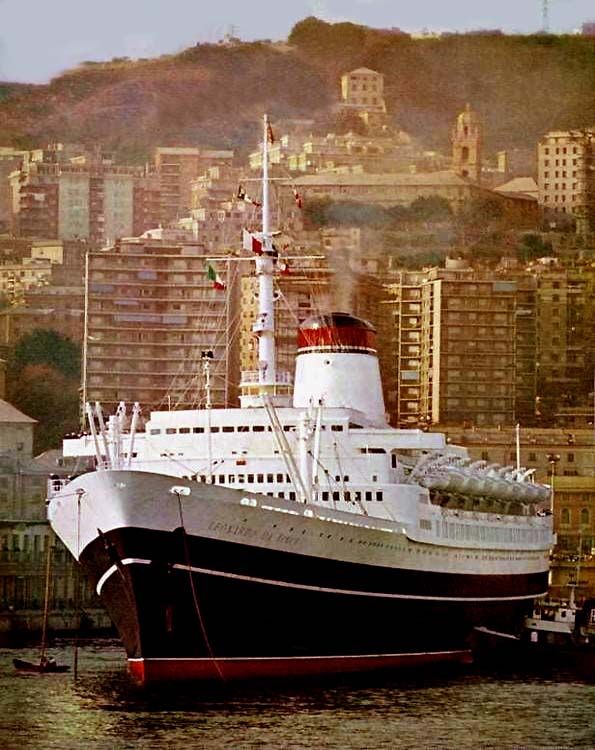
S.S.
Leonardo
da
Vinci is seen at Naples
during her 1965 Trans-Atlantic service to New
York,
until she was called up for refurbishment in 1966
Leonardo
da
Vinci commenced cruises
around the Mediterranean,
however the Italian Line decide that some cabins in Tourist-Class were not up
to standard for cruise duties, as the cabins in question did not have private
facilities. Therefore it was decided to keep those accommodations closed during
her cruise services. This obviously would have an effect, for she would be
cruising with minus 230 passengers than her usual capacity, making a dent in
the profitability, considering her high fuel costs.
However Italian Line decided to schedule S.S.
Leonardo
da
Vinci on one of the most
ambitious cruises ever, and would be a 42-day extensive 21 ports and 14
Countries voyage, being promoted by Italian Line as the “Gala
Cruise.” The itinerary for this amazing cruise was as follows:
March 5, 1966,
depart New York, and head for the following ports, Tenerife, Lisbon, Gibraltar,
Bizerte, Palermo, Istanbul, Rhodes, Alexandra, Port Said, Beirut, Haifa,
Piraeus, Kotos, Budva,
Naples, Genoa, Cannes, Malaga, Algeciras, Madeira, Bermuda, arrive New York on April
16.
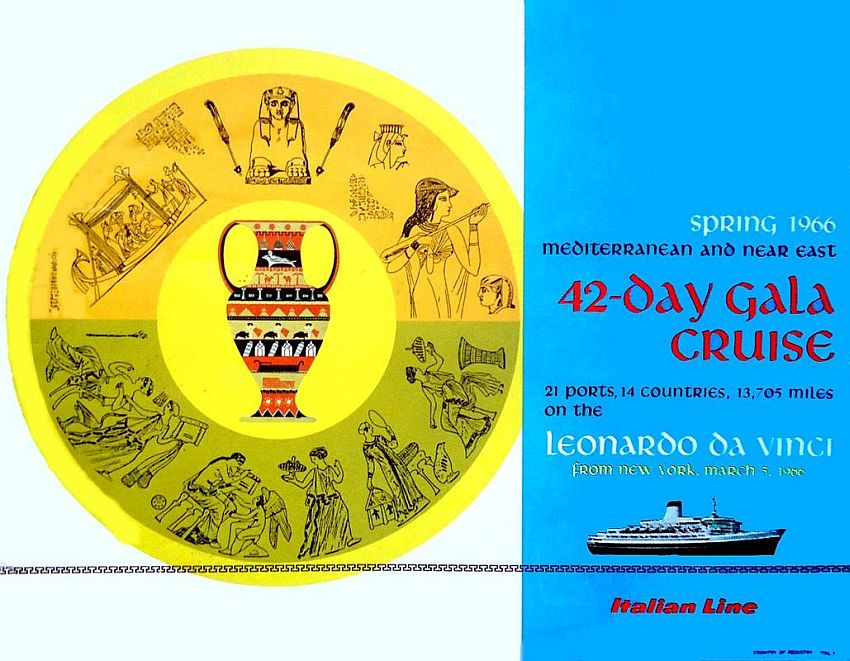
42-day
“Gala Cruise” Brochure cover - More pages of this brochure, as well
as a map of the route taken can be seen on Page Two
A New Look S.S. Leonardo
da
Vinci:
Then in mid 1966 the Italian Line decided
that they would bring the Leonardo
da
Vinci in line with the
Company’s new livery introduced earlier, as seen on their two newest
liners. She would now be painted all white, with her hull given green boot
topping and a longitudinal thin green ribbon.
Although many preferred the more classic look
on her as they considered the black hull a more elegant look. However, in
general cruise ships had become what was known at that time, as the
“cruising white ships”, therefore they were all becoming, what they
call part of the “In-Thing”.
With the makeover as well as an interior
refit, cruise fares could be increased accordingly considering she was
considered as a luxury cruise ship! And soon she commenced on her cruise
schedule and operated a good number of them, yet she still continued regular Trans-Atlantic
liner voyages during the summer months. Cruises were becoming more and more
popular and in general they were operated during the cooler (winter) months as
they offered an escape to warmer climates!
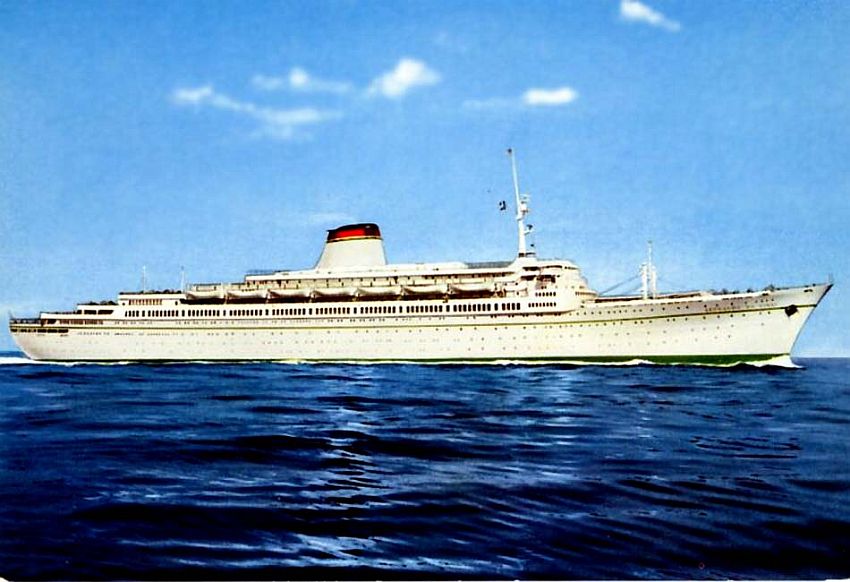
An
Italian Line postcard of a new look, all white S.S.
Leonardo
da
Vinci
S.S. Leonardo da Vinci commenced on yet
another extensive cruise departing in February 1970, being a 41-day voyage
commencing in the Mediterranean sailing via a host of ports including
transiting the Panama
Canal and bound for Hawaii,
from there she would return again to Italy,
thus a very different cruise to the one in March 1966, and it offered a range
of Fly-Cruise opportunities.
The
Final Days of the Traditional Liners:
During the 1970s competition from jet
aircraft became more and more pressing on the North
Atlantic
service. In 1975 the Italian Line decided to withdraw both the
Michelangelo and Raffaello from service.
But despite the withdrawal of state
subsidiaries, the Italian Line did not withdraw from the North
Atlantic
service altogether as the Leonardo da Vinci returned to her original
Trans-Atlantic service, although be it for a short time until June 1976.
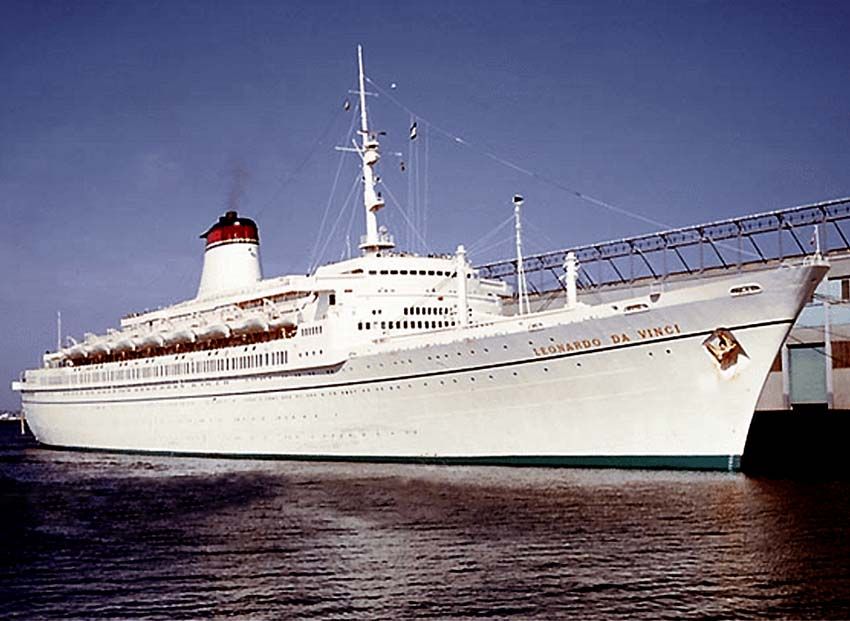
A
gleaming white Leonardo
is flying the Blue Pieter, thus she is due to depart New
York
later that after noon
The photographer
is unknown, *Please view the photo notes at the bottom of this page
As soon as her trans-Atlantic duties had
completed in June 1976, sadly she, like the
Michelangelo and Raffaello were also withdrawn from duties and
laid up at La
Spezia.
However, in 1977 there was a
reprieve, for she was transferred to “Italia
Crociere
Internationali”
(ICI), Genoa,
and
the Leonardo
da
Vinci headed for the
United
States of America
where she would commence a new cruise service. “Costa Cruises”
would operate for as ICI’s General Agents in the USA.
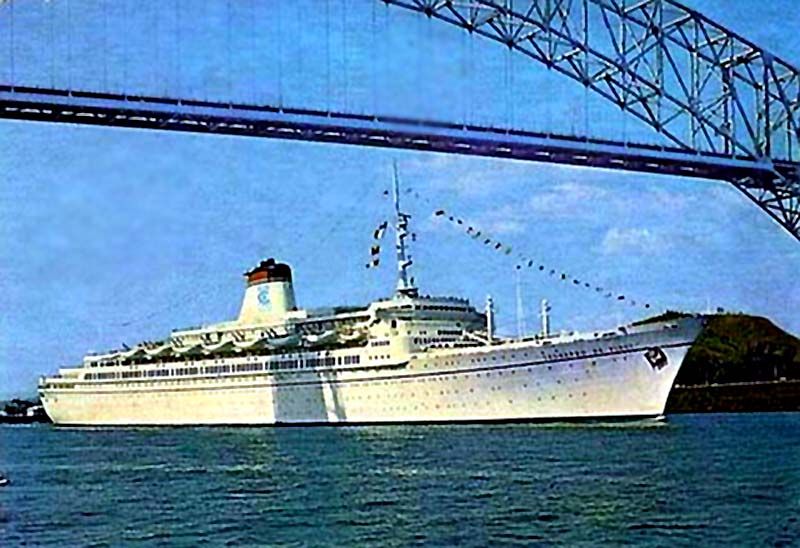
The S.S.
Leonardo
da
Vinci seen in her final
role in 1977
The Leonardo
da
Vinci commenced operating
from Miami
to the Bahamas
on three and four day cruises, meaning she would spend some overnight stays
berthed in the Bahamas.
But the sad fact was, that the Leonardo da Vinci would actually consume more
fuel whilst she was berthed in port, than the majority of other ships would
consume whilst under full speed at sea.
Therefore her cruise role to the Bahamas
was again sadly relatively short lived and thus around a year after returning
to cruising she returned to La
Spezia,
Italy
on September 23, 1978 where ICI had her laid up once again, but this time it
would be for the very last time.
Disaster Strikes the Ship:
The Leonardo
da
Vinci remained laid up at La
Spezia
for two years, but then suddenly a fire erupted aboard the Leonardo
on Friday July 4, 1980 and it rapidly engulfed the entire ship. She burned for
four long days, after which the once beautiful looking ship capsized.
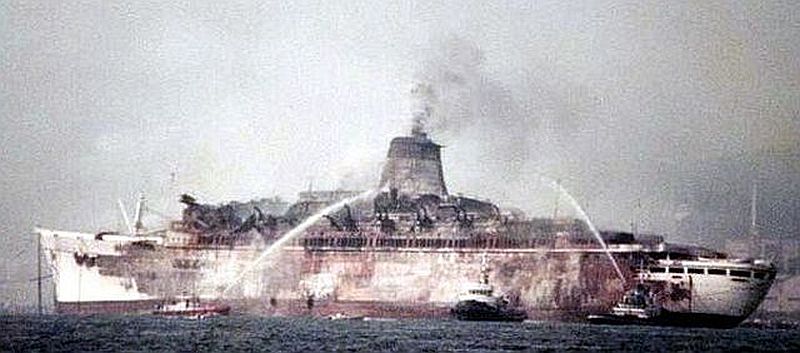
A
tragic scene with the Leonardo
da
Vinci seen on fire
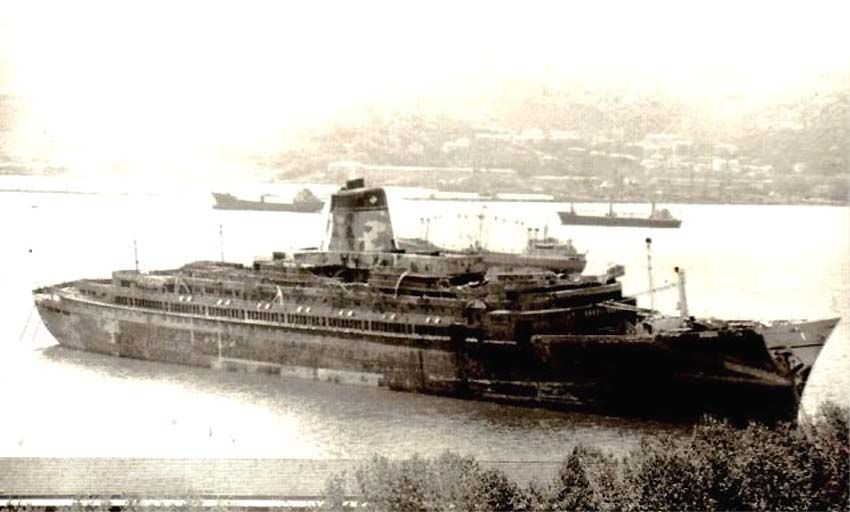
This
once great liner is seen completely burnt out, and she will soon capsize
The
photographer is unknown, *Please view the photo
notes at the bottom of this page
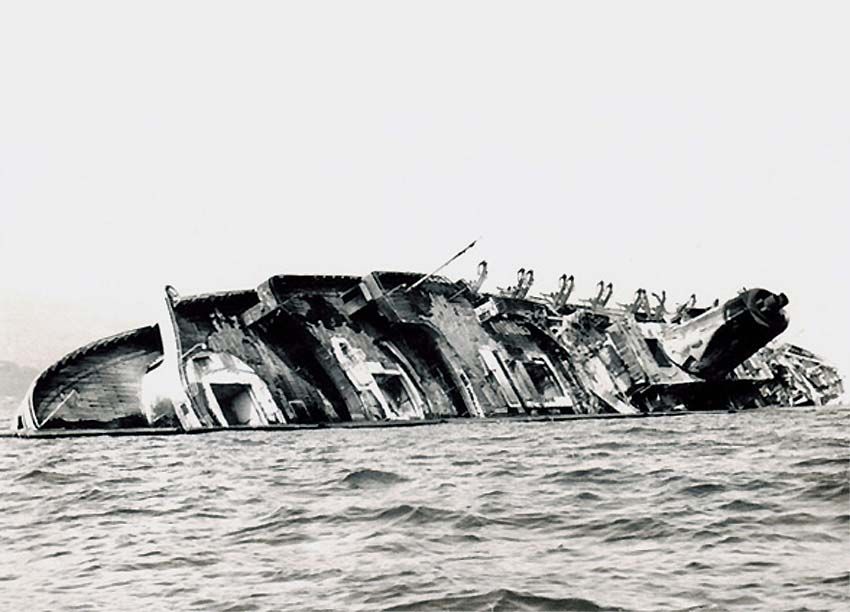
Having
capsized, here we see the Leonardo
partially righted
The
photographer is unknown, *Please view the photo
notes at the bottom of this page
The once so beautiful S.S.
Leonardo
da
Vinci was declared as a
“total constructional loss”. This was without a doubt a sad and a
tragic end to one of the most elegant and stylish looking Italian Line ships
ever built. Many seem to go wild over the weird funnelled S.S.
Michelangelo
and Raffaello, although these ships were stylish, but they did not have a patch
of exterior style and the magnificence of the great S.S.
Leonardo
da
Vinci, although they did
fail her when it came to her underwater hull design!
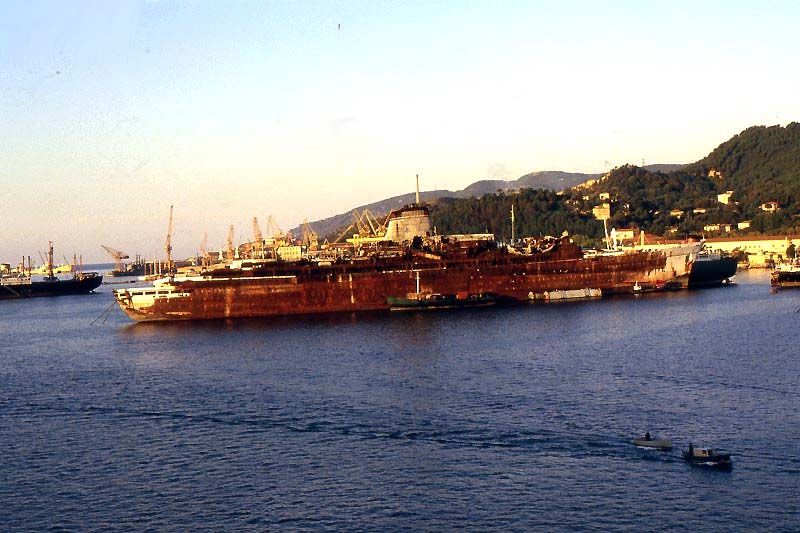
The burnt-out Leonardo
having been righted is now seen at the La
Spezia
breakers yard
Photograph by
& © Alan Blakely
With burnt-out hulk having been righted, she
was towed to the breakers yard of “Cant. Navali
Lotti,” at
La
Spezia,
who broke her up in 1982.
Specifications
for the Leonardo
da
Vinci:
Built
by: Ansaldo
Sestri
Ponete,
Genoa,
Italy
1960.
Yard
N°: 1550.
Launched: December 7, 1958.
Sea Trials: May 19, 1960.
Delivered: in June 1960 to Italia
Line, Genoa.
Maiden Voyage: June 30, 1960 Genoa
to New
York.
Tonnage: 33,340 GRT, 17,227 Net, 5,641 Dwt.
Length: 763.12 ft - 232.60 m.
Beam: 92.19 ft - 28.10 m.
Draught: 31.33 ft - 9.55 m.
Machinery: Four Ansaldo steam turbines.
Power: 38792 kW.
Propellers: 2.
Speed: 23 service speed, 26 maximum.
Passengers: 1,326 total.
. 413 First
Class, 342 Cabin Class, 571 Tourist Class Trans-Atlantic services.
. 984 passengers on Cruises.
. Air-Conditioning throughout the ship.
. Two sets of
Stabilizers.
Broken Up by: Cant. Navali
Lotti,” La
Spezia
in 1982.
In
Conclusion:
Looking back, it was really quite remarkable
for in the very same year the S.S. Leonardo da Vinci commenced sailing, the
Italian Airline “Al Alitalia” had the audacity to challenge their
major competitors the “Italian Line”, both being financially
supported by the Italian Government mind you, and around the same time S.S.
Leonardo da Vinci headed of on her maiden voyage, Alitalia placed their newly
acquired Douglas DC-8 Jetliner on the New
York
service. Thus, Alitalia was stealing countless of Italian Line’s
passengers who would now be flying instead of going by sea as it was so much
faster.
As most will be aware the 1960s sadly
commenced the end for the many of the beautiful traditional classic Liners, be
it the Trans-Atlantic Liners or those that sailed around the globe, even as far
as New Zealand, Australia, Asia and South Africa, etc, including many other
Italian ships did at that time. The Jet age had begun, especially with the
arrival of the Boeing 747, the Jumbo Jet which sounded the end for countless
excellent and most beautiful ships, and many where either sold to Greece,
or were simply broken up.
Remembering … S.S. Leonardo da Vinci
In
service from 1960 to 1977
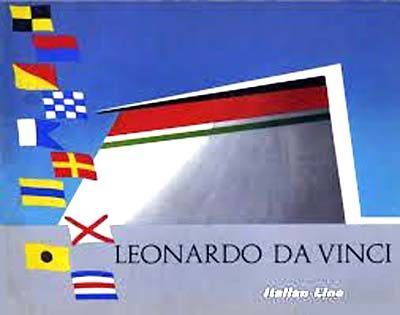
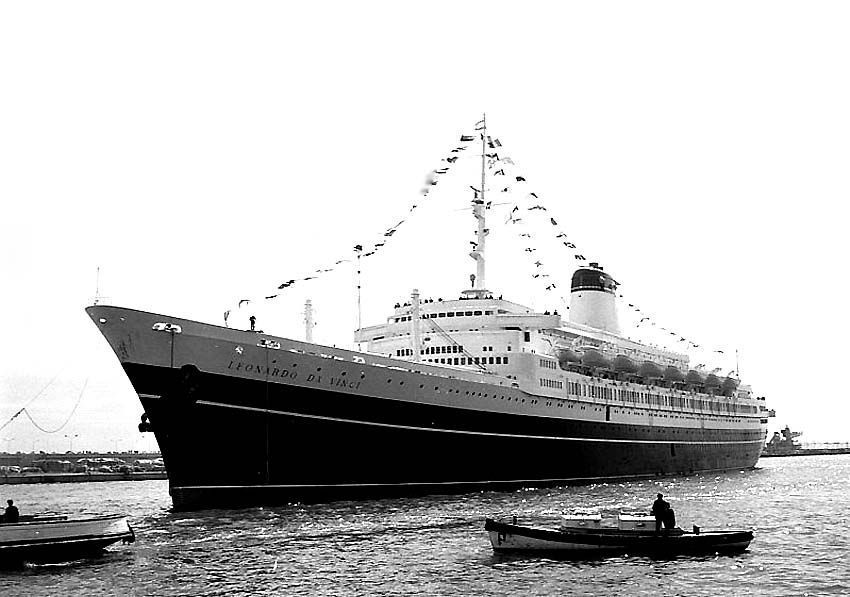
The
great Trans-Atlantic Liner, S.S.
Leonardo
da
Vinci is seen arriving in
port
This
is the way genuine ship lovers prefer to see this fine liner with her original
hull
S.S. Leonardo
da Vinci - INDEX
…
Page One … Her History page. (This Page).
Page Two … Brochures 1958 &
1966, posters, menu & various photographs.
*************************
“Blue Water Liners sailing to the distant
shores.
I watched them come, I watched them go and I
watched them die.”

Featuring over 1,365
Classic Passenger Liners, Passenger-Cargo Liners & Classic Cruise Ships!
Or ENTER HERE
For
interest:
Sadly an email service to ssMaritime is no longer available, due to the
author’s old age and chronic illness as well as being disabled, etc. In
the past ssMaritime received well over 140 emails per day, but Reuben
Goossens
can no longer handle same. He sincerely regrets this!
*************************
ssMaritime.com & ssMaritime.net
Where the ships of the past make history &
the 1914 built MV Doulos Story
The Author has
been in Passenger Shipping & the Cruise Industry for well over 60 years
In addition he was
the founder of “Save the Classic Liners Campaign” in 1990.
Please Note: ssmaritime and associated sites are 100% non-commercial and the
author seeks no funding or favours of any
shape or form, never have and never will!
Photographs on ssmaritime and associate pages are by; the author or from
the author’s private collection. In addition there are some images that
have been provided by Shipping Companies and private photographers or
collectors. Credit is given to all contributors. However, there are some
photographs provided to me without details regarding the photographer/owner concerned.
This notice covers
all pages; although, and I have done my best
to ensure that all photographs are duly credited and that this notice is
displaced on each page, that is, when a page is updated!
ssMaritime is owned & © Copyright by Reuben Goossens -
All Rights Reserved

































